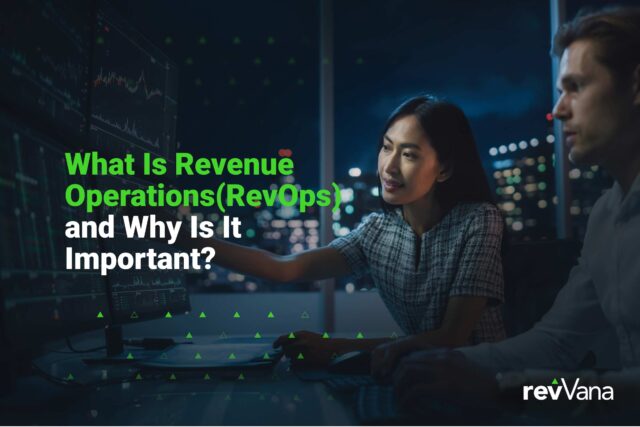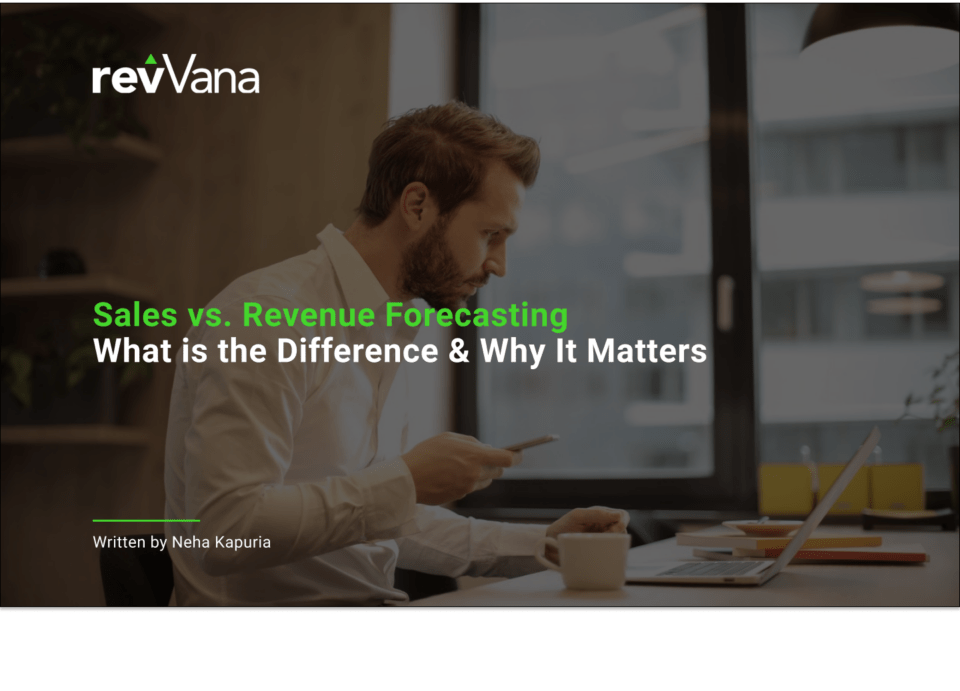

What Is Revenue Operations (RevOps) and Why Is It Important?
Learn about Revenue Operations (RevOps) as a strategy to align siloed revenue teams within B2B and B2C companies and unify revenue goals and targets.

Published on Friday, October 30, 2020
Sales forecasting and revenue forecasting metrics can help SaaS companies determine their monthly recurring revenue (MRR), annual recurring revenue, and future financial health.
Your bookings from sales typically do not appear on a balance sheet, cash flow statement, or income statement in the SaaS world. But they can help your sales team set goals, increase earnings, or even emphasize a company-wide need to get new customers to pay upfront.
Revenue, on the other hand, can directly impact your income statement sheet. Based on GAAP accounting principles, your company can show revenue when it is earned or recognized.
What is revenue? Most CFOs and subscription business leaders understand revenue as a top-line accounting item. Revenue figures sit at the top of your balance sheets and income statements and reflect the full sales price of customer subscriptions over a period of time: annually, quarterly, or monthly.
In essence: Revenue is the amount generated from normal business operations in the sale of goods or services. Accounting principles such as GAAP govern when and how revenue is recognized during a specific period of time.
Accounting reports for both consumer goods or services and the SaaS world converge here because every type of company must report revenue as part of GAAP rules. Accountants report each line item below revenue as an expense or loss deducted from total revenue.
But things get trickier for SaaS companies because they don’t live on “one-and-done” sales like some other organizations. Instead, SaaS companies refer to monthly recurring revenue or MRR. As such, their balance sheets may differ significantly from other types of companies.
For instance, let’s take a simple sample data set:
Fictional startup SaaS company “Magic Marketing” has booked five customers for its “Supreme” package at $200 per month and three customers for its “Sorcerer” package at $100 per month. Each customer committed to a one-year contract, billed monthly.
For the first month, Magic Marketing reports $1,300 in revenue.
Then it gains two more customers at the Sorcerer level. The next month’s revenue is $1,500.
But subscription businesses must also focus on the churn rate, or how often customers cancel their subscriptions. You also want to consider the:
· Number of new bookings
· Life of the subscription or duration of the contract
· Annual Contract Value (ACV) of each customer
The annual contract value is what each customer pays monthly, times 12, without including any one-off upsells, training packages, or other non-recurring revenue. Add all the ACVs up to get the annual recurring revenue (ARR).
Let’s look at the above example, assuming they’ve carried on for a full year. After 12 months, Magic Marketing has a churn of 10%. That means they’re losing one customer each month.
If they haven’t gained any new bookings, their revenue for the 13th month would be $1,400. Of course, if they are also landing new customers, this number would fluctuate monthly. You can also expect revenue to change based on the success of your sales reps, marketing efforts, promotions, and discounts, or even software developments that result in new services and offset your churn.
The physical world of merchandise sales and the SaaS world of subscription businesses also converge to recognized revenue. According to GAAP best practices, using the accrual accounting method, revenue is recognized when earned by the company, not when collected or when it reaches your bank account.
Also, revenue can be recognized only when:
Revenue recognition can get complicated for a SaaS business because some customers pay upfront annually for monthly subscription services (often to receive discount pricing), while some pay monthly.
For customers who pay upfront for the year, you cannot report that revenue until services have been rendered. You would, likewise, pro-rate expenses, such as advertising expenses or salaries of service contractors, so that you’re reporting expenses associated with those accounts receivable in the same month you report the recognized revenue.
So what happens to the remainder of the revenue if a customer has a 12-month contract paid upfront? This “deferred revenue” is reflected as a liability on your balance sheet. Your deferred revenue will vary depending on whether your sales team pushes annual contracts or monthly renewals. And while you may have money in your bank account as a startup with high deferred revenue, your balance sheets won’t reflect that wealth.
You can forecast revenue in several different ways:
Each method may give accurate cash flow predictions depending on:
· The stage your company is in
· Whether seasonality or other outside factors may affect your business
· If you’ve recently introduced new marketing or sales initiatives
revVana helps you get a clear grasp of your revenue by integrating your CRM and financial applications for a single source of truth. By utilizing multiple approaches, these metrics can help you track trends and forecast revenue to assist with setting sales goals, enticing investors, or planning marketing strategies.
You won’t find terms like booking or total contract value (TCV) on GAAP accounting sheets like cash flow or income statements.
These SaaS metrics reflect terminology that pertain to SaaS companies rather than businesses that focus on one-time services or merchandise sold.
What are bookings? And how do bookings numbers differ from revenue?
Bookings refer to the commitment, promise, or contract that a customer will pay money for services rendered. It refers to “closed deals.” It may refer to a physical or electronic contract. It may also be a commitment your salesperson receives or a closed won opportunity in their CRM application.
In the SaaS world, the customer likely signed up for the service, but perhaps their credit card hasn’t been billed yet and/or they have not been invoiced yet.
Bookings can help your SaaS business forecast revenue, as it’s likely that bookings will convert to revenue at some point in the future. Bookings also play an important role in customer acquisition plans. Do your new bookings show you’re likely to reach your sales goals, or is it time to run additional promotions or try new marketing tactics?
When you’re forecasting revenue or bookings, you may also hear the term “total contract value.” TCV is the total of all your bookings for a specific period of time – typically a month, a financial quarter, or a year. It’s often used synonymously with bookings but just emphasizes the point that it’s all the bookings, not just new bookings.
By integrating with your CRM, revVana can help you view important business insights, including bookings, TCV, ARR, and revenue in real-time.
It’s important to note a significant difference between revenue and bookings. Bookings are calculated as a total value before cash is paid, or services are rendered. If you have many customers on annual contracts, deferred revenue could make up the bulk of your booking numbers. On the other hand, if you have monthly contracts but customers credit cards on file with automated billing, there is a reasonable assumption these customers will continue to pay month-after-month. Because they haven’t paid yet, it’s not deferred revenue, but it is part of their total contract value.
Top-down forecasting bookings requires looking at sales trends, new customer acquisition rates, and churn over a set period of time. CRM systems forecast bookings in their pipeline reports based on the sales stage of each opportunity. As with revenue forecasting, you may also want to take into account seasonality, sales, promotions, or new developments and technology enhancements that could increase your market or entice new subscription customers.
Forecasting bookings enables your CFO and sales team to create budgets, set goals, and predict cash flow without reporting inaccurate calculations on balance sheets or income statements, according to generally accepted accounting principles (GAAP).
When you’re forecasting bookings, consider the duration of the contract for a more accurate figure.
For top-down forecasting of bookings, you can use similar methods to revenue forecasting, smoothing out the data to make accurate predictions over time. But before you view your booking forecasts as reliable, compare to your revenue. How many customers that are booked have you converted to revenue?
By integrating sales data, contracts, and data that includes TCV and the LTV (lifetime value) of customers, revVana can help you more accurately forecast bookings and revenue so you can make more strategic business decisions. If you’d like to learn more or schedule a free demo, contact us here.